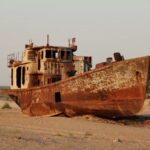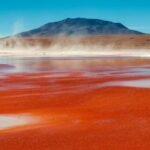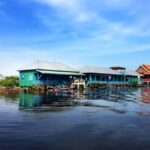Lakes, ubiquitous features of our planet’s landscape, come in a stunning array of shapes, sizes, and compositions. From boiling waters to ancient calderas, these 13 lakes stand out as some of the most bizarre and captivating on Earth.
Laguna Colorada, Bolivia
Laguna Colorada, located in southwestern Bolivia, boasts vibrant orange-red waters, a surreal sight attributed to the presence of red algae thriving in its saline environment. This salt lake serves as a breeding ground for James’s flamingos, adding to its otherworldly allure.

Boiling Lake, Dominica
Dominica’s Boiling Lake, enveloped in billowing steam, presents an otherworldly spectacle. Despite its name, the lake’s temperature hovers below the boiling point due to volcanic gases emanating from deep within the Earth’s crust.
Plitvice Lakes, Croatia
The Plitvice Lakes, a series of interconnected turquoise-blue lakes nestled in central Croatia, captivate visitors with their cascading waterfalls and travertine dams. These ethereal lakes, set against a backdrop of lush forest, form the centerpiece of the Plitvice Lakes National Park.
Lake Nyos, Cameroon
Lake Nyos in Cameroon gained infamy as one of the world’s few exploding lakes. This deadly phenomenon occurs when volcanic activity releases carbon monoxide trapped within the lake, posing a grave threat to nearby communities.

Aral Sea, Kazakhstan and Uzbekistan
Once a sprawling inland sea, the Aral Sea has dwindled into a desolate desert landscape due to extensive diversion of its feeder rivers for irrigation projects. This environmental catastrophe serves as a stark reminder of humanity’s impact on fragile ecosystems.
Pitch Lake, Trinidad
Pitch Lake in Trinidad stands as the world’s largest natural deposit of asphalt, a surreal expanse of viscous black tar. This geological oddity hosts unique microbial life forms and offers tantalizing insights into the potential for life in extreme environments.
Don Juan Pond, Antarctica
Don Juan Pond in Antarctica defies conventional expectations, remaining liquid despite subzero temperatures. With its exceptionally high salinity, this small lake remains an enigmatic anomaly within the frozen continent’s barren landscape.
Dead Sea, Israel and Jordan
The Dead Sea, renowned for its hypersaline waters and buoyant properties, holds the distinction of being the Earth’s lowest point on land. This iconic lake, devoid of conventional aquatic life, presents a stark contrast between its brilliant blue waters and stark desert surroundings.
Klikuk (Spotted Lake), Canada
Klikuk, also known as Spotted Lake, transforms into a patchwork of vibrant colors during the summer months, as mineral-rich pools emerge amid evaporating waters. This sacred site holds cultural significance for the indigenous Syilx people of British Columbia.
Lake Balkhash, Kazakhstan

Lake Balkhash in Kazakhstan exhibits a unique duality, comprising both freshwater and saltwater sections within its expansive basin. This intriguing phenomenon, attributed to varying water sources and evaporation patterns, underscores the dynamic nature of Earth’s hydrological systems.
Tonlé Sap, Cambodia
Tonlé Sap in Cambodia undergoes dramatic seasonal fluctuations, transitioning from a river to a vast lake during the monsoon season. This dynamic ecosystem supports diverse wildlife and sustains local communities through its abundant fisheries.
Crater Lake, USA
Crater Lake in Oregon, formed by the collapse of Mount Mazama, stands as a pristine testament to volcanic activity. With its crystal-clear waters and rugged caldera rim, this natural wonder enthralls visitors with its dramatic beauty.
Lake Baikal, Russia
Lake Baikal in Siberia holds the distinction of being the world’s oldest and deepest freshwater lake, teeming with unique biodiversity. This ancient rift lake, nestled within the Baikal Rift Zone, serves as a natural laboratory for scientific research and exploration.
From scorching deserts to icy tundras, these extraordinary lakes offer glimpses into the diverse landscapes and geological processes that shape our planet’s surface. As testaments to nature’s boundless creativity, they inspire awe and fascination, inviting exploration and discovery in equal measure.























